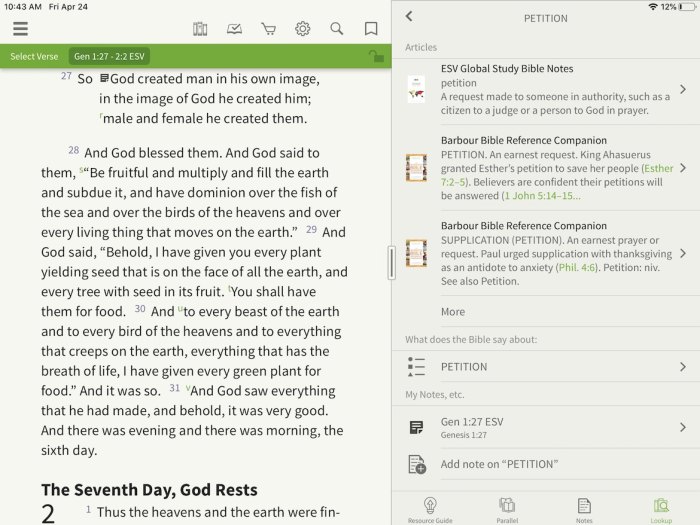Prayer Journal App: In a world increasingly driven by digital connectivity, the quest for spiritual solace finds a new avenue of expression. This exploration delves into the burgeoning market of prayer journal applications, examining their features, user needs, and the intricate dance between technology and faith.
We’ll navigate the competitive landscape, analyze user preferences, and chart a course for the development and marketing of a successful prayer journal app, considering monetization strategies, technical considerations, and the vital role of user experience.
From understanding the motivations behind users seeking digital spaces for prayer reflection to designing intuitive interfaces and robust functionalities, we will uncover the key ingredients for building an app that resonates with a diverse user base. We will also explore the challenges and opportunities inherent in balancing technological innovation with the deeply personal nature of spiritual practice.
This journey promises to illuminate not only the business aspects of developing such an app but also its potential to enrich the lives of those seeking a deeper connection with their faith.
Technical Considerations: Prayer Journal App

The successful development and deployment of a prayer journal application necessitates careful consideration of various technical aspects, ranging from the underlying infrastructure to the security and privacy measures implemented. A robust and scalable architecture is crucial to ensure a positive user experience and the long-term viability of the application.The technical infrastructure for a prayer journal app requires a well-defined architecture encompassing several key components.
This includes a robust database system for storing user data, a secure server infrastructure for hosting the application and managing user requests, and potentially a cloud-based solution for scalability and accessibility. Appropriate APIs will be needed to facilitate data exchange between the application’s front-end and back-end.
Database Selection and Management
Choosing an appropriate database management system (DBMS) is paramount. Relational databases, such as PostgreSQL or MySQL, offer structured data storage and robust querying capabilities, ideal for managing user accounts, prayer entries, and other associated metadata. NoSQL databases, such as MongoDB, provide flexibility for handling semi-structured data, which might be useful for storing user-defined tags or categories within prayer entries.
The selection depends on the anticipated data volume, complexity of data relationships, and scalability requirements. Regular database backups and disaster recovery plans are essential to mitigate data loss.
Server Infrastructure and Scalability
The application’s server infrastructure must be capable of handling concurrent user requests efficiently. Cloud-based solutions, such as Amazon Web Services (AWS) or Google Cloud Platform (GCP), offer scalable and cost-effective options. These platforms provide various services, including virtual servers, load balancing, and database hosting, allowing for easy scaling to accommodate a growing user base.
Proper server configuration and monitoring are crucial to ensure optimal performance and availability. The selection of a suitable server environment must also consider security considerations, such as firewalls and intrusion detection systems.
App Security and Data Privacy
Security and data privacy are paramount. The application must adhere to relevant data protection regulations, such as GDPR and CCPA. This involves implementing robust security measures, including data encryption both in transit and at rest, secure authentication mechanisms (e.g., multi-factor authentication), and regular security audits.
A clearly defined privacy policy outlining how user data is collected, used, and protected is crucial. The app should be designed with security best practices in mind from the outset, employing secure coding techniques and regularly updating dependencies to address vulnerabilities.
Cross-Platform Development: iOS vs. Android, Prayer journal app
The choice between developing native iOS and Android applications or opting for a cross-platform approach presents a significant decision. Native development offers superior performance and access to platform-specific features, but requires separate codebases for each platform, increasing development time and costs.
Cross-platform frameworks, such as React Native or Flutter, allow for code reuse across platforms, reducing development time and cost, but might compromise performance or access to certain native features in some cases. The decision depends on factors such as budget, timeline, and the desired level of platform-specific customization.
For example, a smaller development team with a tighter budget might choose a cross-platform approach, while a larger team with more resources might opt for native development to maximize performance and user experience.
Challenges and Solutions in App Development
Several challenges can arise during the app development process. Careful planning and proactive mitigation strategies are necessary.
- Maintaining Data Consistency Across Platforms:Ensuring data synchronization and consistency across different platforms (iOS and Android) requires careful design of the backend infrastructure and data synchronization mechanisms.
- Managing User Authentication and Authorization:Implementing secure and reliable user authentication and authorization mechanisms is critical to protect user data and prevent unauthorized access.
- Ensuring App Performance and Scalability:Optimizing the application’s performance and scalability to handle a growing user base requires careful consideration of database design, server infrastructure, and caching strategies.
- Addressing Platform-Specific Issues:Different platforms have their own unique characteristics and limitations. Addressing platform-specific issues requires thorough testing and adaptation of the application’s codebase.
End of Discussion
The development of a successful prayer journal app hinges on a delicate balance: understanding the deeply personal nature of prayer and leveraging technology to create a supportive and intuitive space for reflection. By meticulously analyzing market trends, user needs, and technical considerations, and by implementing a robust marketing strategy, developers can create an application that not only meets a growing demand but also fosters a vibrant community of faith-seekers.
The journey, though challenging, offers the potential to profoundly impact the lives of countless individuals on their spiritual journeys.
